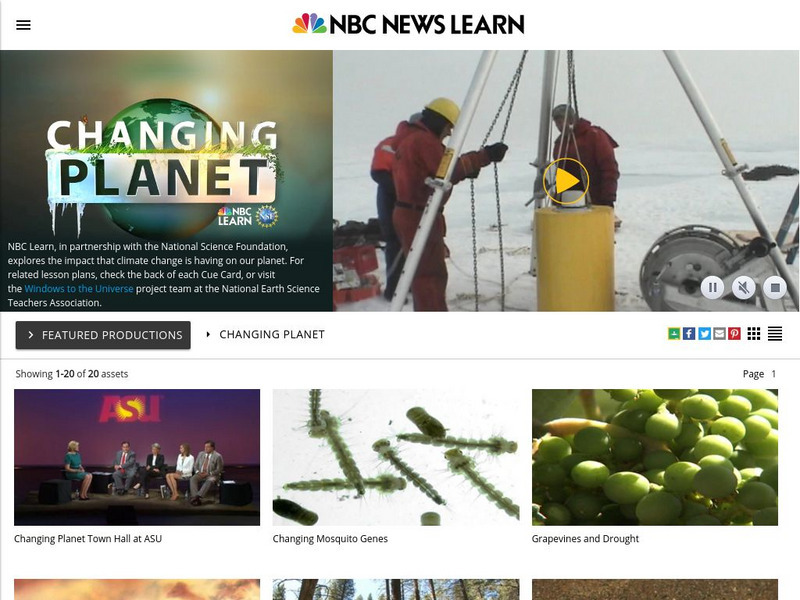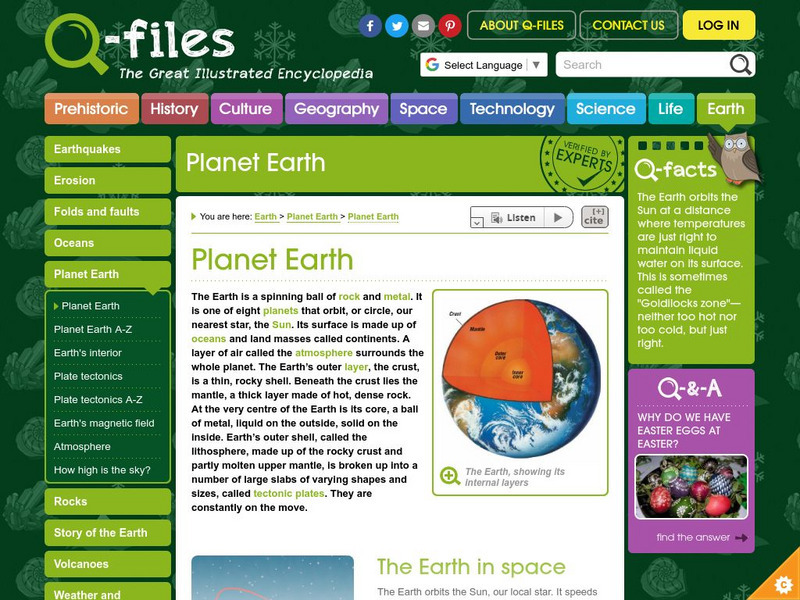Enchanted Learning
Enchanted Learning: The Planets
This survey of the planets includes all the basics, size, mass, atmosphere, length of day, and the like. It features interactive activities and learning exercises and compares all of the planets in colorful tables.
NASA
Nasa: What Is a Planet?
This lesson teaches students about the characteristics of planets, comets, asteroids, and trans-Neptunian objects. After learning about these different things, students then are to debate about a new object that is found in space.
NASA
Nasa: The Space Place: Planet X Treme Weather
Ever wonder what the weather is like on other planets besides Earth? This resource explores the extreme weather that occurs on other planets.
PBS
Pbs Learning Media: All Planet Sizes
This illustration from the Lunar and Planetary Laboratory shows the approximate sizes of the planets relative to each other. Note that the planets are not shown at appropriate distances from the Sun.
Smithsonian Institution
National Air and Space Museum: Exploring the Planets: Our Solar System
Take a tour of our solar system and learn fascinating details and observations about the planets.
Other
Space Science Institute: Alien Earths: Star and Planet Formation
Learn about the lives of stars, and how stars and planets form. The Interactive activity, 'Planet Families' requires Adobe Flash and cannot be launched.
NASA
Dawn Mission: Dawn Classrooms: Dwarf Planets
Students learn about dwarf planet classification through a researched-based instructional strategy called direct vocabulary instruction. Teacher guide and student activity sheet are included.
Massachusetts Institute of Technology
Mit: Open Course Ware: Courses: Extrasolar Planets: Physics and Detection
A university-level course that examines the atmospheres and interiors of extrasolar planets, or exoplanets. The course also looks at the search for planets that could support life. Includes lecture notes and assignments.
PBS
Pbs Learning Media: A Strange New Planet
This video segment adapted from NOVA features the first planet to be discovered outside our solar system. Its surprisingly large size and short orbit sent scientists back to their data and led them to discover similar planets. [3:06]
National Geographic
National Geographic: Extreme Weather on Other Planets
Examine the variety of weather found on all of the planets in the solar system with this classroom exercise. Students will see a video and observe differences and similarities among the planets.
Smithsonian Institution
National Air and Space Museum: Exploring the Planets: Tools of Exploration
Part of the National Air and Space Museum's online exhibition about Exploring Planets, this describes and gives visuals of telescopes, probes and fly-by aircrafts, orbiters, and landers as current methods for earth and airborne...
Smithsonian Institution
National Air and Space Museum: Exploring the Planets: Mercury
This is a useful resource for facts and images pertaining to the planet Mercury.
US Environmental Protection Agency
Epa: Planet Protectors Club for Kids
This site has activities, games and stories starring the Planet Protector's Club. Find out how kids can help our environment. (Several activities include a Spanish version.)
NASA
Nasa: Solar System Exploration: Planets: Venus
Comprehensive look at the planet Venus, with many useful facts, figures, photos, and related links. Provides an account of how Venus got it's name and a timeline of significant dates.
NASA
Nasa: Earth: Overview: Our Home Planet
Provides a comprehensive look at the planet Earth including photos, how Earth got its name, and facts and figures about its size, seasons, moon, atmosphere, rotation, and lithosphere.
DOGO Media
Dogo News: Week of 4 25 16: Stunning Images of Our Beautiful Planet
Beautiful photos of our planet in celebration of Earth Day. Includes video.
NBC
Nbc Learn: Changing Planet
In this video/lesson series we will explore the impact that climate change is having on our planet. Click on the video for related lessons.
Annenberg Foundation
Annenberg Learner: The Habitable Planet: Energy Challenges
With this resource, users join investigators in the exploration of humans' use of and dependence on the many energy resources. Learn about new technologies such as carbon capture and sequestration as an alternative to reduce our carbon...
NASA
Nasa: Uranus: Overview: The Sideways Planet
Detailed look at the planet Uranus, with many useful facts, figures, photos, and related links.
NASA
Nasa: Mercury: Overview: The Swiftest Planet
Comprehensive look at the planet Mercury, with many useful facts, figures, photos, and related links. Provides an account of how Mercury got it's name and a timeline of significant dates.
NASA
Nasa: Neptune: Overview: The Windiest Planet
Prepared by NASA, this site provides a detailed look at the planet Neptune. The menu tabs are divided into overview, moons, rings, photo gallery, and facts and figures. Just click to access specific information on any of these topics.
PBS
Pbs Learning Media: The Planets of the Solar System
As technology has advanced, so do our views and understanding of the solar system. No longer do we have to rely on our unaided eyes to observe planets. View these high-quality images of planets provided by NASA spacecraft.
CK-12 Foundation
Ck 12: Earth Science: Inner Versus Outer Planets Study Guide
An overview of the difference between inner and outer planets of our solar system.
Orpheus Books
Q Files: Planet Earth: Planet Earth
Earth's features and facts are discovered and explained in this brief entry. Identify what makes this planet special.
Other popular searches
- Planets and Astronomy
- Stars and Planets Worksheets
- Stars and Planets Puzzles
- Sun and Planets Wordsearch
- Sun and Planets Word Search
- Planets and Solar System
- Planets and Space
- Planets and Stars
- Comparing Planets and Stars
- Sun and Planets Pictures
- Planets and Seasons
- Planets and Playdough












